Great Rann of Kutch
| Designations | |
|---|---|
| Official name | Kutch |
| Designated | 5 November 2002 |
| Reference no. | 1285[1] |
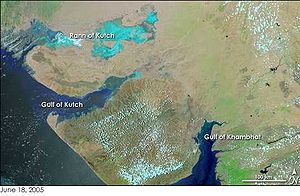
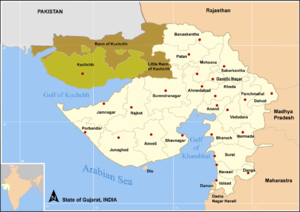

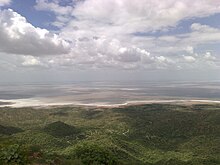
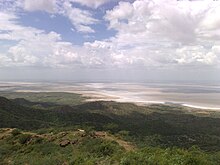

The Great Rann of Kutch (or Rann of Kutch seasonal salt marsh) is a salt marsh in the Thar Desert in the Kutch District of Gujarat, India. It is about 7500 km2 (2900 sq miles) in area and is reputed to be one of the largest salt deserts in the world.[2] This area has been inhabited by the Kutchi people.[3]
The Hindi word is derived from Sanskrit/Vedic word iriṇa (इरिण), meaning the salt flat or barren ground, attested in the Rigveda and Mahabharata. It is the southern extension of the Thar Desert.
Location and description
[edit]The Little Rann of Kutch, including the Banni grasslands on its southern edge, is situated in the district of Kutch and comprises some 30,000 square kilometres (10,000 sq mi) between the Gulf of Kutch and the mouth of the Indus River in southern Pakistan. The marsh can be accessed from the village of Kharaghoda in Surendranagar District.[4] The Great Rann of Kutch together with the Little Rann of Kutch is called Rann of Kutch.
In India's summer monsoon, the flat semi-desert of salty clay and mudflats, which average 15 meters above sea level, fills with standing water. In very wet years, the wetland extends from the Gulf of Kutch on the west through to the Gulf of Khambhat on the east.[5][6]
The area was a vast shallow of the Arabian Sea until continuing geological uplift closed off the connection with the sea, creating a vast lake that was still navigable during the time of Alexander the Great. The Ghaggar River, which presently empties into the semi-desert of northern Rajasthan, formerly emptied into the Rann of Kutch, but the lower reaches of the river dried up as its upstream tributaries were captured by the Indus and Ganges thousands of years ago. Traces of the delta and its distributary channels on the northern boundary of the Rann of Kutch were documented by the Geological Survey of India in 2000.
The Luni River, which originates in Rajasthan, drains into the semi-desert in the northeast corner of the Rann. Other rivers feeding into the marsh include the Rupen from the east and the West Banas River from the northeast.[7] Nara Canal or Puran river which is a delta channel of the Indus River empties during floods into Kori Creek located in the Great Rann of Kutch.
There are sandy islets of thorny scrub, forming a wildlife sanctuary[7] and a breeding ground for some of the largest flocks of greater and lesser flamingos.[8][9] Wildlife, including the Indian wild ass, shelter on islands of higher ground, called bets, during the flooding.
Climate
[edit]This is one of the hottest areas of India – with summer temperatures averaging and peaking at 49.5 °C. Winter temperatures diminish dramatically and can drop to below 0 °C (32 °F).[10]
Threats and preservation
[edit]Although most of the marsh is in protected areas, the habitats are vulnerable to cattle grazing, firewood collection, and salt extraction operations, all of which may involve transportation that disturbs wildlife. There are several wildlife sanctuaries and protected reserves on the Indian side in the Rann of Kutch region. From the city of Bhuj, various ecologically rich and wildlife conservation areas of the Kutch/Kachchh district can be visited such as Indian Wild Ass Sanctuary, Kutch Desert Wildlife Sanctuary, Narayan Sarovar Sanctuary, Kutch Bustard Sanctuary, Banni Grasslands Reserve and Chari-Dhand Wetland Conservation Reserve.[11]
Indo-Pakistan international border
[edit]
In India the northern boundary of the Greater Rann of Kutch forms the International Border between India and Pakistan, it is heavily patrolled by India's Border Security Force (BSF) and the Indian Army conducts exercises here to acclimatize its troops to this harsh terrain.[12]
This inhospitable salty lowland, rich in natural gas, was one scene of perennial border disputes between India and Pakistan that, in April 1965, contributed to the Indo-Pakistani War of 1965. Later the same year, Prime Minister of the United Kingdom Harold Wilson persuaded the combatants to end hostilities and establish a tribunal to resolve the dispute. A verdict was reached in 1968 which saw Pakistan getting 10% of its claim of 9,100 square kilometres (3,500 sq mi). 90% was awarded to India, although India claimed 100% of the region. Tensions spurted again in 1999 during the Atlantique incident.[13] Elements of dispute remain in Sir Creek, since 1969, there have been twelve rounds of talks between the two nations, without a breakthrough. The twelfth round was completed in June 2012.[14]
Indus River floods
[edit]The Indus River had been flowing into Rann of Kutch area and Rann of Kutch used to be its catchment area forming part of its delta.[15][16] Indus river delta branch/channel called Koree river shifted its course after an earthquake in 1819 isolating Rann of Kutch from its delta.[17] Pakistan has constructed the Left Bank Outfall Drain (LBOD) project to bypass the saline and polluted water which is not fit for agriculture use to reach the sea via Rann of Kutch area without passing through the Indus delta.[18] The 500 km long LBOD begins from northern Ghotki district in Sindh province of Pakistan and joins Rann of Kutch in the Badin district of Sindh.[19] Rann of Kutch is the joint water body of India and Pakistan.[20] Water released by the LBOD is enhancing the flooding in India and contaminating the quality of water bodies which are the source of water to salt farms spread over a vast area. The LBOD water is planned to join the sea via disputed Sir Creek but LBOD water is entering Indian territory due to many breaches in its left bank caused by floods.[21]
Chir Batti
[edit]At night, an unexplained strange dancing light phenomenon known locally as Chir Batti (ghost lights) occurs in the Rann,[22][23][24] the adjoining Banni grasslands, and the seasonal wetlands.[25]
Tourism
[edit]This article contains promotional content. (August 2022) |

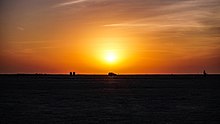
The Government of Gujarat hosts an annual 3-month long Rann Utsav festival from December to February every year[26] near Dhordo village in a 500 km2 white salt desert. Rann Utsav has cultural programs such as the BSF Camel show held at 5 pm, adventure activities like hot-air ballooning, many stalls selling trinkets, handicrafts, food, etc. as well as camel cart excursion, paramotoring, golf carts, ATV rides, yoga and meditation. During the festival 3 to 4-day events are also held at many other exotic locations around the larger Kutch area to expose tourists to the native culture and food, for example, semi-arid grasslands of the Banni reserve exhibits folk architecture, arts and crafts of the area, and folk dance and dance music events are held at several locations with a bonfire under the moon.[27]
Rann Utsav gives visitors not only a chance to experience a full moon on salt deserts but also get a taste of the local culture, cuisine, and hospitality. Specially built local houses are also used to house tourists to give them a taste of local traditions.[28] Many adventure clubs and travel clubs organize expeditions.
Handicrafts
[edit]Some women and young girls make their living by selling different types of Kutch embroidered cloths. The embroidery is of various styles such as Rabari, Ahir, Sindhi, Banni, Mutwa, Ari and Soof, some of which include mirror or bead inlays. [29] Rogan work also.
Popular culture
[edit]J. P. Dutta's Bollywood film Refugee was shot in the Great Rann of Kutch along with other locations in the Kachchh district. It is said to have been inspired by the story by Keki N. Daruwalla based around the Great Rann of Kutch titled Love Across the Salt Desert.[30][31][32][33][34][35][36]
Amitabh Bachchan in his promotions for Gujarat Tourism titled Khushboo Gujarat Ki has also extensively shot in the Rann of kutch.[37] Several scenes in Salman Rushdie's Booker Prize winning novel Midnight's Children take place in the Rann of Kutch, including a scene where the protagonist faints from heatstroke in the Rann's brutal climate. Some scenes or song sequences in Indian films like Magadheera, D-Day, R... Rajkumar, Gori Tere Pyaar Mein, Goliyon Ki Raasleela Ram-Leela, Lagaan, The Good Road, Dookudu, Sarvam, Sarrainodu and Roberrt were shot in the area.[38]
See also
[edit]References
[edit]- ^ "Runn of Kutch". Ramsar Sites Information Service. Retrieved 25 April 2018.
- ^ "Gujarat Tourism Document" (PDF). Gujarattourism.com. Archived from the original (PDF) on 12 December 2010. Retrieved 22 November 2013.
- ^ INTERNATIONAL LAW REPORTS VOLUME 50. Cambridge University Press. 1976. p. 464. ISBN 9780406876522.
- ^ Negi, S.S. (1996). Biosphere reserves in India : landuse, biodiversity and conservation. New Delhi: Indus Pub. Co. ISBN 978-81-7387-043-9.
- ^ At its greatest extent, the Gulf of Kutch on the west (visible in the image directly below the salt marshes) and the Gulf of Cambay on the east (the brown, sediment-tinged body of water on the lower right) are both united during the monsoon. "Rann of Kutch, India". Earth Snapshot. 6 November 2008. p. 2. Archived from the original on 2 December 2013. Retrieved 22 November 2013.
- ^ Chisholm, Hugh, ed. (1911). . Encyclopædia Britannica. Vol. 7 (11th ed.). Cambridge University Press. p. 670.
- ^ a b "Rann of Kutch seasonal salt marsh". Terrestrial Ecoregions. World Wildlife Fund.
- ^ Gandhi, Divya (22 December 2018). "How Mumbai's residents fought, and won, a battle on behalf of flamingos". The Hindu. ISSN 0971-751X. Retrieved 23 February 2020.
Flamingos — lesser and greater — are found across the country, and migrate from as far as Iran. Many of those that flock to Mumbai come from sites closer home, such as Gujarat's Rann of Kutch, where they breed and nest on mudflats
- ^ Kannadasan, Akila (10 February 2020). "Flocktails and friendship". The Hindu. ISSN 0971-751X. Retrieved 23 February 2020.
The flamingoes come from the Rann of Kutch in Gujarat in December and leave towards the end of March.
- ^ "Encyclopaedia of Earth". Eoearth.org. Retrieved 22 November 2013.
- ^ runnutsav (23 April 2015). "Places to visit in Kutch, Gujarat". Rann Utsav. Retrieved 2 January 2024.
- ^ "Cease Fire and After: Better Security in Western India". Link. 14 (2). New Delhi: United India Periodicals: 13. 1971.
- ^ Verinder Grover, ed. (1998). 50 years of Indo-Pak relations – the initial phase : partition of India, Indo-Pak wars, the UNO. New Delhi: Deep & Deep Publ. ISBN 978-81-7629-057-9.
- ^ "Talks on Sir Creek begin between India-Pak". Archived from the original on 20 June 2012.
- ^ "Two disasters that defined India's south-west border with Pakistan for ever". Retrieved 22 December 2015.
- ^ "Anthropocene Metamorphosis of the Indus Delta and Lower Floodplain" (PDF). Retrieved 22 December 2015.
- ^ "Indus re-enters India after two centuries, feeds Little Rann, Nal Sarovar". Retrieved 22 December 2015.
- ^ "Revisiting the LBOD issue". Archived from the original on 9 February 2016. Retrieved 22 December 2015.
- ^ "Sindh floods: LBOD was a mistake, experts finally agree with residents". 29 November 2011. Retrieved 22 December 2015.
- ^ "LBOD the culprit behind recurring floods in Sindh". 29 September 2011. Retrieved 22 December 2015.
- ^ "Evolution of the Delta, the LBOD outfall system and the Badin dhands – chapters 3 & 4" (PDF). Retrieved 22 December 2015.
- ^ "INDIA TODAY GROUP: India Today, Business Today, Aaj Tak, Care Today, Mail Today, Cosmopolitan, Reader's Digest, India Today Conclave". Intoday.in. Retrieved 22 November 2013.
- ^ [1][dead link]
- ^ "In Today – Blogs, Photos, Videos, sports and Business". Archive.is. 3 August 2012. Archived from the original on 3 August 2012. Retrieved 22 November 2013.
- ^ [2] Archived 14 January 2009 at the Wayback Machine
- ^ Gautam, Shikha (25 October 2018). "Rann Utsav this year - all that you need to know". India Times. Retrieved 26 August 2022.
- ^ All the excitement of Gujarat'ss Rann Utsav, Femina, 29 November 2019.
- ^ "Rann Utsav | Fairs & Festivals | Home". Gujarat Tourism. 13 November 2013. Archived from the original on 18 January 2012. Retrieved 22 November 2013.
- ^ "Rann Utsav 2009 | Fairs & Festivals | Home". Gujarat Tourism. Archived from the original on 9 January 2012. Retrieved 22 November 2013.
- ^ "LOVE ACROSS THE SALT DESERT – binaljavia". Learnhub.com. Archived from the original on 2 December 2013. Retrieved 22 November 2013.
- ^ "Love across The Salt Desert" (PDF). Cns.bu.edu. Archived from the original (PDF) on 19 July 2011. Retrieved 23 November 2013.
- ^ "LOVE ACROSS THE SALT DESERT know more – binaljavia". Learnhub.com. Archived from the original on 2 December 2013. Retrieved 22 November 2013.
- ^ [3] Archived 29 January 2011 at the Wayback Machine
- ^ "Google Drive Viewer". Retrieved 22 November 2013.
- ^ "Indian School Certificate (Year-12) : List of Prescribed Textbooks" (PDF). Archived from the original (PDF) on 22 November 2012. Retrieved 23 November 2013.
- ^ [4] Archived 10 April 2009 at the Wayback Machine
- ^ "Akshar Travels khushboo gujarat ki..call us 1800 233 9008". YouTube. 27 August 2010. Retrieved 22 November 2013.
- ^ Mishra, Abhimanyu (26 September 2013). "The Rann of Kutch is emerging as the favourite with filmmakers". The Times of India. Archived from the original on 7 October 2013. Retrieved 3 February 2014.
- World Wildlife Fund, ed. (2001). "Rann of Kutch seasonal salt marsh". WildWorld Ecoregion Profile. National Geographic Society. Archived from the original on 8 March 2010.
External links
[edit]- Gujarat Tourism official website
- "World Wildlife Fund:". Terrestrial Ecoregions. World Wildlife Fund. Terrestrial Ecoregions: Rann of Kutch
- Satellite views comparing summer and winter conditions in the Rann of Kutch Archived 6 September 2005 at the Wayback Machine
- Desert (Rann of Kutch) wetlands; 6 February 2003; WWF Global website
- KACHCHH PENINSULA AND THE GREAT RANN; The Geological Survey of India, Ministry of Mines, Government of India
- Archived news articles from the India Environmental Portal on: Rann of Kutch
- Archived news articles from the India Environmental Portal for a Search made for: Banni grasslands[permanent dead link]
